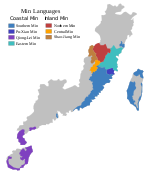Yong'an dialect
| Yong'an dialect | |
|---|---|
| 永安事 | |
| Pronunciation | [uã˧ um˧ sia˧˥] |
| Native to | Southern China |
| Region | Yong'an, Sanming, Fujian |
Sino-Tibetan
| |
Early forms | |
| Language codes | |
| ISO 639-3 | – |
| Glottolog | None |
| Linguasphere | 79-AAA-hbc |
The Yong'an dialect (Central Min: 永安事, Mandarin Chinese: 永安話) is a Central Min dialect spoken in Yong'an, Sanming in Western Fujian Province, China.
Phonology
The Yong'an dialect has 17 initials, 41 rimes and 6 tones.
Initials
The initials of the Yong'an dialect are:
| Bilabial | Dental | Palato-alveolar | Velar | Glottal | |
|---|---|---|---|---|---|
| Nasal / Approximant | m | n ~ l | ŋ | ||
| Plosive | p pʰ | t tʰ | k kʰ | ʔ | |
| Affricate | ts tsʰ | tʃ tʃʰ | |||
| Fricative | s | ʃ | h |
- The initials [n] and [l] occur in free variation.
- /m, ŋ/ can also be heard as voiced plosives [b, ɡ] in free variation.
- Palato-alveolar sounds /tʃ, tʃʰ, ʃ/ can also be heard as alveolo-palatal sounds [tɕ, tɕʰ, ɕ] in free variation among speakers.
Rimes
The Yong'an dialect has a rich set of oral and nasal vowels, but allows only -m and -ŋ as a final consonant.
| Open syllable | Nasal coda | Nasal vowel coda | ||
|---|---|---|---|---|
| Open mouth | ɹ̩ i a ɔ o ø e ɯ | aɯ ɔu | m am ɔm ãŋ ẽĩŋ | ã õ |
| Even mouth | i ia iɔ iø ie iɯ | iau | iam iẽĩŋ | ĩ iã iõ |
| Closed mouth | u uɔ ue ui | um uẽĩŋ | uã | |
| Round mouth | y ya ye yi | ym yẽĩŋ | ||
Tones
The tones are:
| Middle Chinese tone | ||||
|---|---|---|---|---|
| level | rising | departing | entering | |
| upper | 53 | 21 | 35 | 13 |
| lower | 32 | 43 | (> lower rising) | |
Tone sandhi
The Yong'an dialect has extremely extensive tone sandhi rules: in an utterance, only the last syllable pronounced is not affected by the rules. The two-syllable tonal sandhi rules are shown in the table below:
| Original citation tone | Tone sandhi |
|---|---|
| upper level | lower level |
| lower level | remain unchanged |
| upper rising | lower level |
| lower rising | upper rising |
| departing | remain unchanged |
| entering | high level (55) |
Notes
References
- ^ Mei, Tsu-lin (1970), "Tones and prosody in Middle Chinese and the origin of the rising tone", Harvard Journal of Asiatic Studies, 30: 86–110, doi:10.2307/2718766, JSTOR 2718766
- ^ Pulleyblank, Edwin G. (1984), Middle Chinese: A study in Historical Phonology, Vancouver: University of British Columbia Press, p. 3, ISBN 978-0-7748-0192-8
- ^ Hammarström, Harald; Forkel, Robert; Haspelmath, Martin; Bank, Sebastian (2023-07-10). "Glottolog 4.8 - Min". Glottolog. Leipzig: Max Planck Institute for Evolutionary Anthropology. doi:10.5281/zenodo.7398962. Archived from the original on 2023-10-13. Retrieved 2023-10-13.
Sources
- Norman, Jerry (1974). "The Initials of Proto-Min". Journal of Chinese Linguistics. 2 (1): 27–36. JSTOR 23749809.
- Zhou, Changji 周长楫; Lin, Baoqing 林宝卿 (1992). Yong'an Shi difangzhi bianweihui 永安市地方志编委会 (ed.). Yǒng'ān fāngyán 永安方言 [Yong'an Dialect] (in Chinese). Xiamen: Xiamen daxue chubanshe.
- Yong'an Shi difangzhi bianzuan weiyuanhui 永安市地方志编纂委员会 (1994). Yǒng'ān Shì zhì 永安市志 [Chorography of Yong'an City] (in Chinese). Vol. 36. Beijing Shi: Zhonghua shuju. ISBN 7-101-01280-9.

